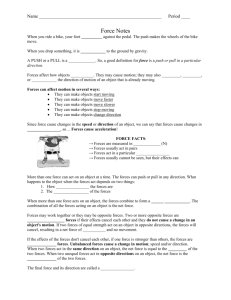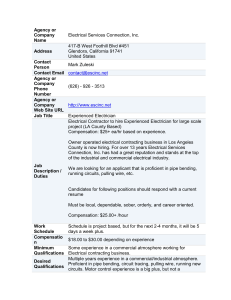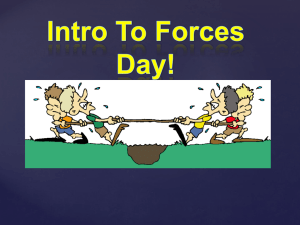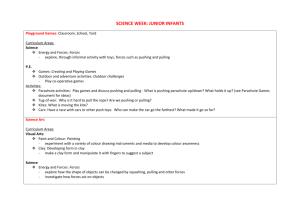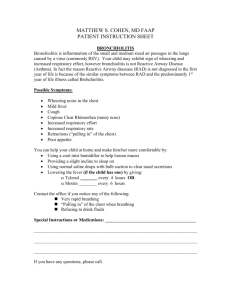Unit 4- Pulling Back - The SCAN Foundation
advertisement
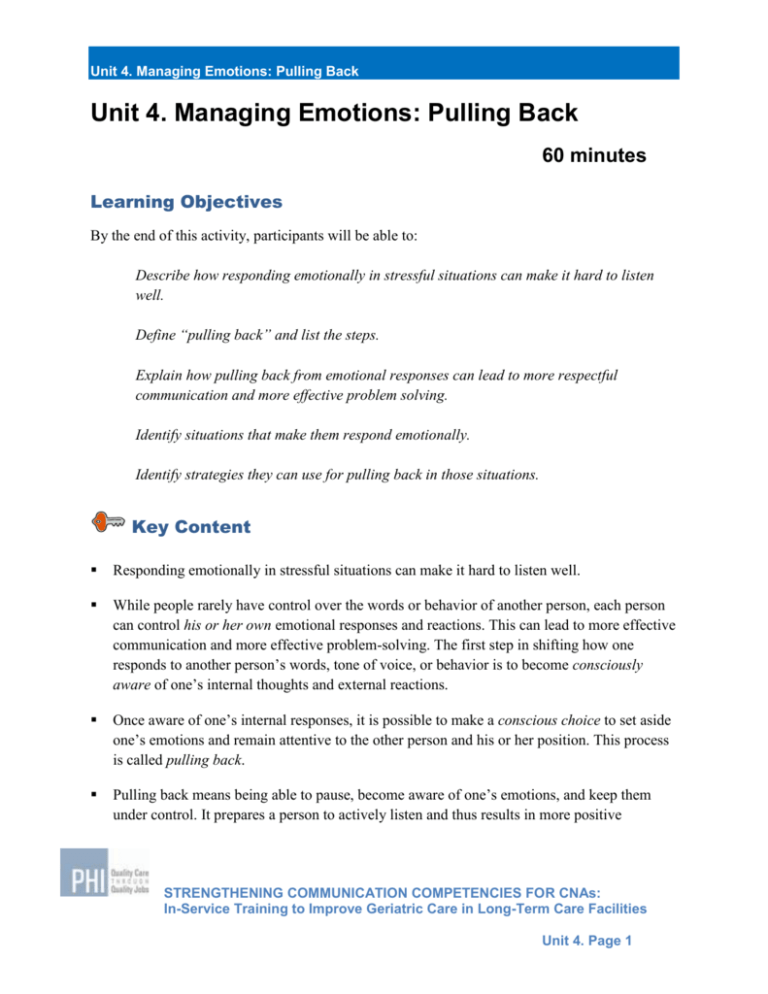
Unit 4. Managing Emotions: Pulling Back Unit 4. Managing Emotions: Pulling Back 60 minutes Learning Objectives By the end of this activity, participants will be able to: Describe how responding emotionally in stressful situations can make it hard to listen well. Define “pulling back” and list the steps. Explain how pulling back from emotional responses can lead to more respectful communication and more effective problem solving. Identify situations that make them respond emotionally. Identify strategies they can use for pulling back in those situations. Key Content Responding emotionally in stressful situations can make it hard to listen well. While people rarely have control over the words or behavior of another person, each person can control his or her own emotional responses and reactions. This can lead to more effective communication and more effective problem-solving. The first step in shifting how one responds to another person’s words, tone of voice, or behavior is to become consciously aware of one’s internal thoughts and external reactions. Once aware of one’s internal responses, it is possible to make a conscious choice to set aside one’s emotions and remain attentive to the other person and his or her position. This process is called pulling back. Pulling back means being able to pause, become aware of one’s emotions, and keep them under control. It prepares a person to actively listen and thus results in more positive STRENGTHENING COMMUNICATION COMPETENCIES FOR CNAs: In-Service Training to Improve Geriatric Care in Long-Term Care Facilities Unit 4. Page 1 Unit 4. Managing Emotions: Pulling Back communication and outcomes. Managing emotions is essential to active listening. It is also important for establishing and maintaining good relationships with co-workers and with residents. This contributes to the CNA’s ability to provide resident-centered care. Practical pull-back strategies can help both in the moment and when preparing for potentially stressful situations. Supplies and Other Training Materials Flip chart, easel, markers, and tape Paper and pens or pencils Instructor’s Guide, Unit 4: Scripted Role Play—Not Pulling Back Instructor’s Guide, Unit 4: Scripted Role Play—Pulling Back Handouts Handout 4-A: Reacting Emotionally vs. Pulling Back—You Choose Handout 4-B: Pulling Back—An Overview Handout 4-C: Trigger Points—When Emotions Get in the Way of Listening… Handout 4-D: Pull-Back Strategies Advance Preparation Review the teaching materials for each activity. Note that icons are used to remind the instructor of the following: When you are presenting or covering Key Content in the discussion. (Key Content is also addressed in many of the handouts.) When it is important to ask a particular question to get participants’ input. When it is time to distribute and discuss a handout. Copy the handouts for all participants. Steps 3 and 9 involve scripted role plays to demonstrate pulling back. This should ideally be done with a co-instructor. However, if there is no co-instructor, ask a colleague or a staff member from your facility to help you (not a participant). In the Activity Steps, we refer to STRENGTHENING COMMUNICATION COMPETENCIES FOR CNAs: In-Service Training to Improve Geriatric Care in Long-Term Care Facilities Unit 4. Page 2 Unit 4. Managing Emotions: Pulling Back this staff person as your “assistant.” Make two copies of the scripted role plays (see Instructor’s Guide, Unit 4: Scripted Role Play—Not Pulling Back and Scripted Role Play—Pulling Back, pages 10-13). Use a highlighter to mark all of “Julie’s” parts on one copy; use a different color highlighter to mark all of “Mr. Jackson’s” parts on the other copy. Give “Mr. Jackson’s” script to the person who will be helping you with the role plays. (You will play the role of the CNA, Julie, in order to emphasize the body language and other signs of pulling back—and not pulling back.) Rehearse both role plays together a couple of times, to be sure you are each clear about your roles. When not pulling back, you should exaggerate the signs of frustration, but never cross the boundary of acting unprofessional. When pulling back, you also need to exaggerate the body language cues so that it’s clear to participants what you’re doing to set aside your frustration. Be prepared to share personal experiences of situations that have triggered your emotions, choices you’ve made in those situations, and successful pull-back strategies you use. Prepare the following flip chart pages: “Managing Emotions: Pulling Back—Learning Objectives” (Step 1) “Steps for Pulling Back” (Step 7) “Strategies for Pulling Back” (Step 10) Set up the workshop space to allow for large-group discussion and small-group work. Set up the flip chart easel for optimum viewing by all participants. Activity Steps (1-20) First Demonstration Role Play and Large-Group Discussion—10 minutes 1. Welcome participants and introduce the topic. Note that they have already learned important skills for active listening—using body language effectively, paraphrasing, and asking open-ended questions. Even with the best skills, however, there are times in our work when something happens that brings up a lot of emotions for us, and it becomes hard to even remember to listen. Ask participants: Does this sound familiar to anyone? STRENGTHENING COMMUNICATION COMPETENCIES FOR CNAs: In-Service Training to Improve Geriatric Care in Long-Term Care Facilities Unit 4. Page 3 Unit 4. Managing Emotions: Pulling Back After seeing heads nod, note that they will get a chance to talk about some of those situations later in this session. For now, you want to describe the learning objectives of this session. Post and review the prepared flip chart page. Flip Chart MANAGING EMOTIONS: PULLING BACK Learning Objectives: Describe how responding emotionally in stressful situations can make it hard to listen well. Define “pulling back” and list the steps. Explain how pulling back from emotional responses can lead to better communication and problem-solving. Identify situations that make you respond emotionally. Identify strategies you can use for pulling back in those situations. Teaching Tip This is the maximum amount of writing to put on a flip chart page. You may need to prepare two pages (if you are working with a large group and need to write larger so everyone can read it), or create a handout with these learning objectives. 2. Introduce the role play. Explain that you will now conduct a brief role play to demonstrate one such situation. Ask your “assistant” to come forward (see Advance Preparation). Describe the setting and explain your roles (see Instructor’s Guide, Unit 4: Scripted Role Play—Not Pulling Back, pages 10-11). Ask participants to focus on the actions and words of the CNA, Julie. Teaching Tip As the lead instructor, you will play the CNA, “Julie,” and you will emphasize not pulling back. STRENGTHENING COMMUNICATION COMPETENCIES FOR CNAs: In-Service Training to Improve Geriatric Care in Long-Term Care Facilities Unit 4. Page 4 Unit 4. Managing Emotions: Pulling Back 3. Conduct the demonstration role play for NOT pulling back. Teaching Tip Follow the script on pages 10-11. Be as realistic as possible while demonstrating not pulling back, but do not over-play the character; do not act unprofessional. 4. Debrief the first role play. Ask the following questions and facilitate a discussion. What did you observe about “Julie’s” response to “Mr. Jackson”? How do you think “Mr. Jackson” felt? Interactive Presentation—10 minutes 5. Summarize the impact of responding emotionally. Thank participants for their observations. Note that “Julie” responded out of an emotional place. Review the first two bullets in Key Content. 6. Distribute and review Handout 4-A: Reacting Emotionally vs. Pulling Back—You Choose. Emphasize that pulling back is a conscious choice. 7. Distribute and review Handout 4-B: Pulling Back: An Overview. Define “pulling back” and discuss the bullets that follow. Post the prepared flip chart page to emphasize the “Steps for Pulling Back.” STRENGTHENING COMMUNICATION COMPETENCIES FOR CNAs: In-Service Training to Improve Geriatric Care in Long-Term Care Facilities Unit 4. Page 5 Unit 4. Managing Emotions: Pulling Back Flip Chart STEPS FOR PULLING BACK 1. Notice your emotional reactions and judgments. 2. “Freeze” your reaction—put it aside. 3. Put your attention back on the other person. Second Demonstration Role Play and Large-Group Discussion—10 minutes 8. Set up the second role play. Note that the scenario will be the same as in the first role play. Explain that, this time, “Julie” has gone through this training and will try to pull back. The same people will play the same roles in order to clearly show the difference in the behaviors. Ask participants to observe what is different about this role play, looking for verbal and nonverbal signs of pulling back. 9. Conduct the demonstration role play for pulling back. Teaching Tips Use the Instructor’s Guide, Unit 4: Scripted Role Play—Pulling Back (pages 12-13). When playing “Julie,” the CNA, be sure to exaggerate the pull-back strategiesfor example, taking a deep breath and waiting a few seconds before respondingso they are visible for the audience. The other role player should show a positive response when Julie pulls back, but not overdo it. 10. Debrief the second role play. Ask participants: What did you observe this time about “Julie’s” response to “Mr. Jackson”? Specifically, what signs of pulling back did you see? STRENGTHENING COMMUNICATION COMPETENCIES FOR CNAs: In-Service Training to Improve Geriatric Care in Long-Term Care Facilities Unit 4. Page 6 Unit 4. Managing Emotions: Pulling Back Note participants’ observations on a flip chart page, “Strategies for Pulling Back.” Flip Chart STRATEGIES FOR PULLING BACK Then ask: How do you think “Mr. Jackson” was feeling by the end of the role play? Individual Exercise—5 minutes 11. Explain the purpose of this exercise. Remind participants that pulling back is a conscious choice. The first step of pulling back is to “notice their emotional reactions and judgments.” Thus, it is important to become aware of what kind of situations lead to an emotional reaction for them as individuals—that is, situations where they need to pull back. 12. Distribute Handout 4-C: Trigger Points—When Emotions Get in the Way of Listening…. Explain that they will have five minutes to read the list of situations and put a check mark next to each situation that leads to an emotional response for them. Explain that there are no “right” or “wrong” answers to this—the goal is just to increase their awareness of the kinds of situations in which they respond emotionally. If they think of any other situations that affect them emotionally, they can add them to the list. Note that these handouts will not be collected. Pairs Work and Reporting—15 minutes 13. Shift focus to pull-back strategies. Acknowledge the difficulty of staying calm and thinking clearly when under stress. Reiterate that pulling back is not about changing another STRENGTHENING COMMUNICATION COMPETENCIES FOR CNAs: In-Service Training to Improve Geriatric Care in Long-Term Care Facilities Unit 4. Page 7 Unit 4. Managing Emotions: Pulling Back person—it’s about changing our own reaction, so that we can listen attentively and have a more positive outcome. Note that everyone uses one or more strategies to pull back in stressful situations. The goal of this activity is for participants to become aware of their own pull-back strategies, strengthen them, and learn new ones. 14. Form pairs and give instructions. To save time, ask participants to pair up with someone sitting close to them. In their pairs, they will share the “trigger points” that they checked on Handout 4-C, and then discuss pull-back strategies that they have used successfully in the past. Ask them to write two pull-back strategies at the bottom on Handout 4-C. Ask them to try to think of one “in the moment” strategy and one that they use when they plan ahead for dealing with situations that may be emotionally challenging. 15. Monitor time. Note that they will have 5 minutes for sharing and discussing pull-back strategies in their pairs. Give a “time-check” after 3 minutes, to make sure both members of the pair get a chance to talk. 16. Facilitate pairs reporting. Ask one pair to volunteer to begin, by sharing two of their pullback strategies. Add any new strategies to the flip chart page that you started in Step 10. Note which strategies are used in the moment and which ones are used ahead of time. Teaching Tip For examples of pull-back strategies, see Handout 4-D: Pull-Back Strategies. Distribute the handout to participants AFTER this discussion, so that participants will come up with their own ideas about pull-back strategies. Some strategies that are identified may avoid conflict but do not contribute to effective listening (for example: just leaving the room to avoid yelling at the person). Redirect or reframe such responses before writing them on the flip chart page. For example, ask the group: “How might you use this strategy (leaving the room) and do it respectfully?” (For example, you could explain to the person that you need to walk away at this point, but will come back later when you can listen better). Interactive Presentation—5 minutes 17. Summarize pull-back strategies. Distribute and review Handout 4-D: Pull-Back Strategies. Highlight any strategies that were not mentioned in the discussion. STRENGTHENING COMMUNICATION COMPETENCIES FOR CNAs: In-Service Training to Improve Geriatric Care in Long-Term Care Facilities Unit 4. Page 8 Unit 4. Managing Emotions: Pulling Back 18. Wrap up the discussion. To close, remind participants that managing emotions is essential to active listening. It is also important for establishing and maintaining good relationships with co-workers and with residents. This contributes to the CNA’s ability to provide resident-centered care. Large-Group Exercise—5 minutes 19. Conduct a closing go-round. Wrap up the session by asking participants: How can you use pulling back to be more “resident-centered” in your work? Teaching Tips Conducting this as a “go-round” means that each person gets a chance to answer, without anyone interrupting or asking questions. Usually, you ask for a volunteer to start and then you move to the next person, and the next, until everyone has answered. Participants can “pass” if they wish, but you always come back to them at the end to give them another chance to answer. It’s important for every person to say something about what they learned and how they can apply it. It not only shows what they are thinking, but, in some cases, it may trigger their thinking in a way that did not happen earlier in the session. 20. Thank participants for their participation! STRENGTHENING COMMUNICATION COMPETENCIES FOR CNAs: In-Service Training to Improve Geriatric Care in Long-Term Care Facilities Unit 4. Page 9 Unit 4. Managing Emotions: Pulling Back Instructor’s Guide, Unit 4: Scripted Role Play—Not Pulling Back Setting [read aloud before starting the role play]: The CNA (Julie) has just finished helping a resident (Mr. Jackson) to get dressed and ready for the weekly singing activity. The shift is short-staffed and several call bells have gone off while she’s been helping Mr. Jackson decide on what to wear. Julie: There, Mr. Jackson, you’re finally ready to go to singing. We’ve already missed the first 10 minutes because it took so long for you to make up your mind about what to wear! And I’ve got to get to that call bell that’s been going off. Mr. Jackson: You know, I really don’t want to wear these shoes. They’re already hurting my feet. Get me my brown shoes—like I told you in the first place. Julie (extremely frustrated): Mr. Jackson! We don’t have time to change your shoes AGAIN! The program’s already started and it’s going to take too long to help you put on another pair of shoes. Don’t worry about walking—I’ll push you there in the wheelchair. Mr. Jackson: I don’t want NO wheelchair! I can walk there myself—AND QUITE COMFORTABLY, TOO—if you’d just stop wasting time and help me get my brown shoes on! Julie: (very frustrated tone—without raising voice) Mr. Jackson, we just took almost 20 minutes getting you ready to go and I don’t have any more time to help you. I’ve got to get to that call bell, or I’ll be hearing it from my supervisor! STRENGTHENING COMMUNICATION COMPETENCIES FOR CNAs: In-Service Training to Improve Geriatric Care in Long-Term Care Facilities Unit 4. Page 10 Unit 4. Managing Emotions: Pulling Back Instructor’s Guide, Unit 4: Scripted Role Play—Not Pulling Back (page 2) Mr. Jackson: You aides are all alike—always racing off to help someone else when you haven’t finished helping the first person! All you care about is pushing and shoving us around to get your jobs done fast. And I thought we’re supposed to get what we want in this place—when we want it!! Julie (almost shouting): Mr. Jackson! You are not the ONLY resident in here that we’re trying to care for! So, you have a choice—I can either take you in the wheelchair to the activity right now—or you’re just going to have to miss singing today. But I’ve given you all the time I can this morning! End of First Role Play STRENGTHENING COMMUNICATION COMPETENCIES FOR CNAs: In-Service Training to Improve Geriatric Care in Long-Term Care Facilities Unit 4. Page 11 Unit 4. Managing Emotions: Pulling Back Instructor’s Guide, Unit 4: Scripted Role Play—Pulling Back Setting [same as the first role play]: The CNA (Julie) has just finished helping her resident (Mr. Jackson) to get dressed and ready for the weekly singing activity. The shift is short-staffed and several call bells have gone off while she’s been helping Mr. Jackson decide on what to wear. Julie: There, Mr. Jackson, you’re finally ready to go to singing. We’ve already missed the first 10 minutes because it took so long for you to make up your mind about what to wear! And I’ve got to get to that call bell that’s been going off. Mr. Jackson: You know, I really don’t want to wear these shoes. They’re already hurting my feet. Get me my brown shoes—like I told you in the first place. Julie (taking a deep breath and closing her eyes for a moment): Mr. Jackson, I’m really sorry but I’m worried about the resident who has been ringing that call bell, with no one answering. Mr. Jackson: That happens to me all the time—I ring and ring and no one comes! Well, you’re helping me now and that person can wait. These shoes hurt my feet! Julie (looking down and away quickly before responding calmly): Mr. Jackson, I do want to continue helping you, but what if that person is having a serious problem? Wouldn’t you want one of us to come right away if you were having a serious problem? Instructor’s Guide, Unit 4: Scripted Role Play—Pulling Back STRENGTHENING COMMUNICATION COMPETENCIES FOR CNAs: In-Service Training to Improve Geriatric Care in Long-Term Care Facilities Unit 4. Page 12 Unit 4. Managing Emotions: Pulling Back (page 2) Mr. Jackson: You aides are all alike—always racing off to help someone else when you haven’t finished helping the first person! All you care about is pushing and shoving us around to get your jobs done fast. And I thought we’re supposed to get what we want in this place—when we want it!! Julie (visibly pausing and taking another deep breath, then speaking softly): Mr. Jackson, we are short-staffed this morning and I have to take care of more residents than usual. I’m sorry about that. But I need to check on that call bell now and I’d like to give you a choice. I can take you to the singing in a wheelchair so your feet won’t hurt so much, or you can wait here for me while I check on the call bell. Mr. Jackson: Well, we’re late already—I guess I can wait. But you better not take a coffee break before you come back! Julie: Thanks, Mr. Jackson, I knew you’d understand. I’ll be back as soon as I can—and no coffee until after I get you to the singing. End of Second Role Play STRENGTHENING COMMUNICATION COMPETENCIES FOR CNAs: In-Service Training to Improve Geriatric Care in Long-Term Care Facilities Unit 4. Page 13
